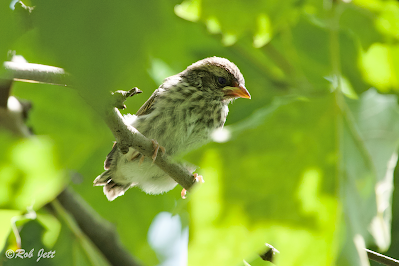While Brooklyn's coastal habitats are seeing a noticeable increase in southbound species (primarily shorebirds & seabirds), week 30 in Green-Wood Cemetery saw more subtle transformations.
I had assumed that the breeding season ended a few weeks ago, so was surprised to see: a recently fledged mockingbird, a recently hatched Chipping Sparrow and a robin feeding hatchlings on a nest near Sylvan Water.
 |
Northern Mockingbird fledgling
|
 |
Chipping Sparrow
|
 |
American Robin with hatchling
|
A few warbler species have been trickling into the area with Yellow Warbler being the most visible. Northern Waterthrush has joined the earlier arriving Louisiana Waterthrush. The Solitary Sandpiper is no longer alone as it has been joined by Spotted Sandpipers.
 |
Northern Waterthrush
|
 |
Spotted Sandpiper
|
There were quite a few botanics in bloom last week, helping feed the increasing number of pollinators seen around the cemetery. My favorite spots are still around Valley Water and a short stretch of plantings along Central Avenue. I also discovered that the plantings at the Civil War Monument was humming with insects. Most notably a large number and diversity of dragonflies were patrolling the east side of the monument.
 |
| Buttonbush |
 |
Crape Myrtle
|
 |
| Sourwood |
 |
| Queen Anne's Lace |
 |
| Dogbane |
 |
Giant Fleeceflower
|
 |
Virginia Mountain Mint
|
It was interesting to note all the various species of garlic that have dropped their blooms (ready to sauté?).
 |
Garlic sp.
|
I'm finally see some diversity in the skipper butterflies. Prior to last week I'd only been seeing Sachems skippers. These very small butterflies are difficult to separate, but I was able to photograph several Crossline and Zabulon Skippers last week.
 |
Zabulon Skipper
|
 |
Crossline Skipper
|
The number of dragonflies throughout the cemetery has greatly increased. While many of those species are migrating through the area, several are locally breeding. The full list from last week is: Familiar Bluet, Swamp Darner, Common Green Darner, Comet Darner, Eastern Pondhawk, Twelve-spotted Skimmer, Great Blue Skimmer, Blue Dasher, Wandering Glider, Spot-winged Glider, Eastern Amberwing, Common Whitetail, Ruby/Cherry-faced Meadowhawk, Carolina Saddlebags and Black Saddlebags. The Common Whitetail does not migrate, but will mate, lay its eggs in the ponds (or a puddle), then die. The individuals we'll see next summer are those offspring beginning the cycle again.
 |
Eastern Pondhawk
|
 |
Common Whitetail
|
 |
Familiar Bluet
|
One of my favorite moths is the tiny Ailanthus Webworm Moth. Often mistaken for a beetle due to the way they hold their wings close to their body, this beneficial, diurnal moth is easy to overlook due to its small size.
 |
| Ailanthus Webworm Moth on Joe-Pye Weed |
Here's a nice selection of frequently unnoticed bee species from last week.
 |
Long-horned Bee
|
 |
Golden Northern Bumblebee
|
 |
Leaf-cutter Bee
|
I found a tiny, little clay "pot" attached to a plant stalk. When I learned that it was created by a Potter Wasp, I went down a rabbit hole trying to learn about these miniscule insects. I wanted to figure out which species created the beautifully crafted mud nursery. Most of the wasp species I'd observed were way too large. One that I photographed is the Mexican Grass-carrying Wasp. They don't make pots. The second wasp I had a difficult time identifying. Finally, I realized that it wasn't, in fact, a wasp. It was a look alike, probably evolved to keep potential predators from eating them. This was actually a fly called the Thick-headed Fly (Physocephala tibialis). Nature, man!
 |
Potter Wasp nest
|
 |
Mexican Grass-carrying Wasp
|
 |
| Thick-headed Fly (Physocephala tibialis) |
These are the trees I observed last week that have begun fruiting.
 |
| Ginkgo |
 |
Shagbark Hickory
|
 |
American Chestnut
|
 |
Northern Catalpa
|
 |
Common Persimmon
|
Finally, yesterday morning I encountered an Eastern Red Bat sleeping in the middle of Lawn Avenue. At first, I thought it was just a dead leaf and stepped over it. My friend Jim realized it was a bat and called me back. We weren't sure if it was injured or just fell from its roost and decided to stay on the road. We tried to coax it out of the road and onto the side of a large oak tree. It very vocally objected to our help and eventually flew up to a close tree where it remained for the rest of the day. Eastern Red Bats migrate in the Fall, so I'm not certain if this is a locally breeding individual or if their migration has already begun. The International Bat Conservancy has a lot of good information
here.
 |
Eastern Red Bat
|












































































